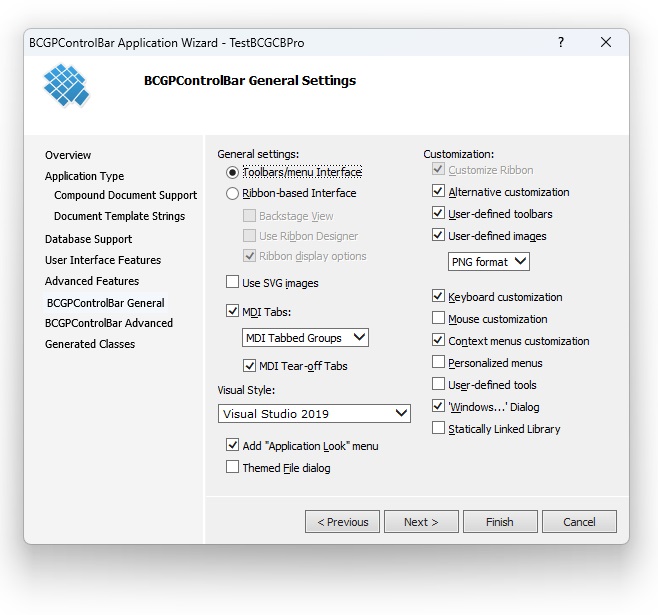In this article we'll describe how to create a new application in Visual Studio 2005-2015 environments.
- Run Visual Studio developer environment.
- Choose "File | New | Project..." menu item.
- Select "Visual C++ Projects" Project type, 'BCGPAppWizard'
folder and then choose the "MFC Application" icon. This will start the regular MFC AppWizard
(with 2 additional pages) that
creates the executable.
Specify your general MFC application settings and switch to
"BCGControlBar General" page. Please note, that this page is not available
for a dialog-based MFC application.

-
Toolbars/menu interface. Choose this option if
you wish to create a application with "classic" (toolbar/menu-based user
interface).
-
Ribbon-based interface. Choose this option if you
wish to create Office 2007-2024 style application with the
ribbon bar.
-
Backstage View. Check this item if you wish to
create your Ribbon bar with Backstage view
.
-
Use Ribbon Designer. If this item is checked, the
project will be created with Ribbon
Designer
resources. Otherwise, the Ribbon bar will be initialized in
source code.
-
MDI Tabs. Your MDI application will be created
with MDI Tabbed Groups or MDI Tabs on Caption.
If your application is SDI, this option will be disabled.
-
Visual Style. Choose the Visual Theme (such as
Office 2010 or
Visual Studio
2010
) that will be initially applied to your application.
-
Add "Application Look" menu. Check this option if
you wish to allow the user modifying the application look at run-time.
If your application is toolbar/menu based, "Application Look" menu item
will appear under the "View" menu. In the Ribbon bar, "Style" menu will
be placed on the right side
- Themed File dialog. Replaces all standard (Windows) file dialogs with themed (visual manager-based) dialogs.
-
Alternative customization ("Alt+Drag")
Allows to drag
and drop toolbar/menu items
without invocation of the customization
dialog.
-
User-defined toolbars. Adds an ability to
create custom
toolbars
at run-time.
-
User-defined images. Allows to associate toolbar buttons with
user-defined bitmaps. The images can be either PNG or SVG.
-
Keyboard customization. Adds to your project
keyboard shortcuts customization.
-
Mouse customization. Adds to your project
customization of the mouse events.
-
Context menus customization. Adds to your project a
context menu customization.
-
Personalized Menus. Shows recently used menu items first. If you do not choose this option,
all menu items will be shown.
-
User-defined Tools. Adds an ability to customize
user-defined (usually external) tools at
run-time.
-
"Windows..." dialog. Check this option if you
wish to replace the standard "Windows..." dialog by
enhanced
(MDI applications only).
-
Statically Linked Library. Your project will be
linked with BCGControlBar Library statically. This option cannot be used
in Evaluation version!
Click "Next" button and switch to "BCGControlBar Advanced
Settings" page:

-
Shortcuts ("Outlook"-style) bar. Check this
option if you want to add a
Shortcuts Bar.
-
Embedded Control. Shortcuts bar will be created
with an embedded control.
-
Caption Bar. Check this option if you want to add
a Caption Bar.
-
Docking Workspace bar. Adds an example of a
workspace bar with
detachable tabs.
-
Docking Output bar. Adds an example of an output
bar.
-
Docking Property Grid. Adds a Visual Studio-style property grid.
-
Docking Task Pane. Adds a Microsoft Office-style tasks pane.
-
Docking Toolbox Pane. Adds a Visual Studio-style toolbox.
-
Enable AutoHide. Enables "Auto Hide Window" feature for all docking panes.
-
Docking Type. Choose control bars docking style.
You can select:
- Graphics manager. Check this option if you want to use a graphics manager (Direct2D or GDI+) to draw content of your CView-derived class. By default, this option is unchecked.
- Automatically hide scroll bars: enables auto-hidden scrollbars. By default, this option is unchecked.
Back to the Developer Area